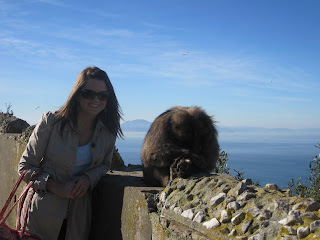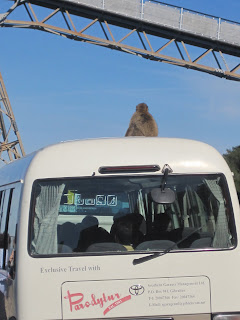

Yep, that's a cash register (I was completely obsessed with playing "store" and was not satisfied with a simple toy cash register. I wanted a real one and every time I went to Staples with my parents, I would go to the aisle with cash registers and play with them. I sadly never received my cash register :-(
And yes, the second thing is a cute, cuddly pet monkey. No, I didn't ever get a pet monkey (aren't my parents just mean?!? haha that's a joke - I have the greatest parents a girl could ask for). However, I think I was able to satisfy my desire to have a pet monkey this weekend with a simple trip to Gibraltar. Gibraltar is famous for the monkeys that live on the rock and I have to say they were quite entertaining. I will write more about the day in Gibraltar in a different post - this one will be dedicated entirely to the monkeys :-)
Here is a bit of info in case you'd like to familiarize yourself with the history of the monkeys
The Barbary Apes of Gibraltar, Macaca Sylvanus, are actually tail-less monkeys and are an unusual and delightful attraction for anyone visiting Gibraltar or the Costa del Sol. No one is really sure how the only wild apes in Europe arrived in Gibraltar. The two most popular explanations as to the appearance of the apes of Gibraltar is either that they crossed via a subterranean tunnel from their native Morocco or British sailors introduced them having picked them up on their travels. Whatever the explanation they readily adapted to their new habitat and have lived, bred and been an integral part of Gibraltar for some centuries now.
Gibraltar Monkey History
The Gibraltar monkey population was under the care of the British Army and later the Gibraltar Regiment from 1915 to 1991, who carefully controlled a population that initially consisted of a single troop. An officer was appointed to supervise their welfare, and a food allowance of fruit, vegetables and nuts was included in the budget. Births were gazetted in true military fashion, and each new arrival was named. Following the withdrawal of the British garrison, the Government of Gibraltar took over responsibility for the monkeys.
Currently the monkeys are managed by the Gibraltar Ornithological and Natural History Society (GONHS) and veterinarian expertise is provided by the Gibraltar Veterinary Clinic (GVC). The macaques receive a daily supply of fresh water and vegetables, fruit and seeds as supplement to natural food resources (leaves, olives, roots, seeds and flowers).
The animals are caught on a regular basis in order to check their health status. Additionally, body size, weight and several other measures are taken. Finally, the animals are given a tattoo number and a micro chip as a means of identification. But tattoos are not the only way to recognise animals. Barbary macaques quite often show particular marks, scars or spots which can be used as distinguishing features. All monkeys are photographed and the pictures together with individual characteristics catalogued.
Anywho, needless to say, they were VERY entertaining. They were spending their Saturday doing many things:
Grooming each other

Having a mid-morning snack

Spending quality family time together

Sleeping

Doing Yoga

Hitching a ride on the bus (yes, it was moving as I took this picture)

Trying to rob harmless Americans

Getting piggy-back errr "monkey-back" rides

Contemplating life from behind bars

Leaning on a pal after a hard day

Then of course, it's always entertaining to do imitations!



Here is an awesome video that Tad put together with some of my pictures and the videos we took from the day. Enjoy!!

1 comment:
Wow. Great time with the monkeys. Great song to go with it also. I kept thinking, "Oh, do they have fleas?"
Post a Comment